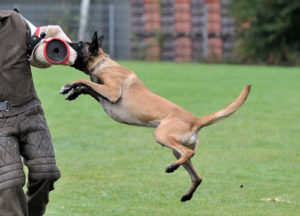 IPO, formerly known as Schutzhund (literally “protection dog”), was originally developed as a breed suitability test for the German Shepherd Dog. In the early days, German Shepherds were considered the ultimate working dog. Not only did they tend and guard livestock, they protected their owners and served alongside police and military personnel. While it eventually turned into a German dog sport, it has since evolved further into the largest protection sport competition in the world. There are club, regional, national, and international events that dog and handler teams are capable of participating in. Considered the triathlon for dogs, IPO is a three phase sport that tests a dog’s temperament and physical soundness for work and breeding.
IPO, formerly known as Schutzhund (literally “protection dog”), was originally developed as a breed suitability test for the German Shepherd Dog. In the early days, German Shepherds were considered the ultimate working dog. Not only did they tend and guard livestock, they protected their owners and served alongside police and military personnel. While it eventually turned into a German dog sport, it has since evolved further into the largest protection sport competition in the world. There are club, regional, national, and international events that dog and handler teams are capable of participating in. Considered the triathlon for dogs, IPO is a three phase sport that tests a dog’s temperament and physical soundness for work and breeding.
While initially only German Shepherd Dogs were eligible, any breed can now compete in the sport. However, it’s very rare to see a breed that has not been bred specifically for work to do well. Most commonly, you’ll find German Shepherds, Belgian Malinois, Rottweilers, Dutch Shepherds and Dobermans competing successfully. These dogs have many generations of bloodlines created to maintain the temperament necessary for serious work. While IPO is a sport, the dogs it tests and promotes are used for police and military work. It is nearly impossible to find rescue dogs that can successfully compete and fight a perpetrator the way these dogs can.
The protection phase is the most iconic phase in IPO. It consists of the dog and handler team and a perpetrator called a helper. The helper wears a protective sleeve over his arm to keep him safe when the dog attacks. In IPO, dogs are specifically taught to attack the forearm of the helper. There are various exercises in the protection phase, such as a blind search for the helper and a full-field attack. Each exercise shows different aspects of the dog’s mental stability and willingness to fight.
But protection is not the only phase in IPO. Equally important are the other two: tracking and obedience. Tracking is done with the dog following the scent of his handler or a stranger. The dog works at a 10 meter distance from the handler, and the handler must follow the dog as he guides him along the track. Depending on the level the team is competing in, the tracks are 100-600 paces and contain a number of articles the dog must locate. Articles are any piece of leather or other material that are hidden on the track. The dog must not only find them, but indicate them to the handler by lying down. Tracking demonstrates the search and rescue capabilities of the dog, as well as his concentration and focus on daunting tasks for extended periods.
Although obedience is in almost every dog sport, the obedience in IPO is extremely strict and specific. The dogs must be animated and focused in the heeling, have precise positions, and fast and steady jumps and retrieves. The dog must perform a long down under gunfire and throughout another team’s routine. The obedience is very heavily judged, and the points can fall off surprisingly fast. In a club level competition, the pressure will not be as serious as it will be at a national, but the dogs are still required to perform various exercises with precision and speed. The focused heeling many people so often see in other obedience competitions today originated in IPO.
 The sport of IPO has three different levels – IPO I, II, and III. The titles must be obtained in order, and before a dog is allowed to move into the IPO tests, heust pass a BH. The BH is a temperament test that shows a dog’s obedience and ability to work through the next phases of the sport. While the BH is pass or fail, each level of IPO contains 300 points (100 points for each of the three phases) and the dog and handler teams must obtain a minimum of 70 points in each phase to achieve the title. All three phases are done over one or two days and only need to be passed under one judge.
The sport of IPO has three different levels – IPO I, II, and III. The titles must be obtained in order, and before a dog is allowed to move into the IPO tests, heust pass a BH. The BH is a temperament test that shows a dog’s obedience and ability to work through the next phases of the sport. While the BH is pass or fail, each level of IPO contains 300 points (100 points for each of the three phases) and the dog and handler teams must obtain a minimum of 70 points in each phase to achieve the title. All three phases are done over one or two days and only need to be passed under one judge.
If you’re interested in learning more about IPO, there are a number of organizations dedicated to promoting the sport. You can check with your local working breed clubs, for example, the American Working Malinois Association, or search the all-breed organizations such as the American Working Dog Federation. Whether you’ve got a dog suited for the work or not, spectators are always welcome. The various phases of IPO test the dogs under so many conditions, it’s difficult not to admire how strong and dedicated the teams are. Even if you only want to learn, clubs and events are extremely welcoming. After all, dog sports are just made up of dog-loving people! You may want to leave your pet pooch at home when you visit, but you’d be surprised how warm and friendly even the serious competitors are!
About the Author
Katie is a professional dog trainer located in Southern California, with a background of experience as a veterinary assistant as well. She has trained and competed with multiple breeds in AKC Obedience and Rally, agility, herding, Schutzhund/IPO, French Ring and conformation. She has been involved in dogs since she was a child, and specializes in protection dogs, working dogs, and aggression issues. You can visit her website, Katie’s Dog Training, to find out more information about her training and accomplishments. When she’s not helping others and writing, she’s out on the field with her Belgian Malinois and Pembroke Welsh Corgi.
